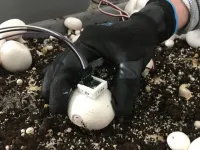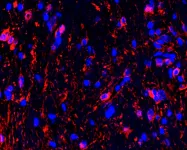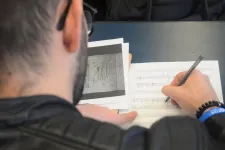(Press-News.org) Researchers in Penn State's College of Agricultural Sciences have developed a robotic mechanism for mushroom picking and trimming and demonstrated its effectiveness for the automated harvesting of button mushrooms.
In a new study, the prototype, which is designed to be integrated with a machine vision system, showed that it is capable of both picking and trimming mushrooms growing in a shelf system.
The research is consequential, according to lead author Long He, assistant professor of agricultural and biological engineering, because the mushroom industry has been facing labor shortages and rising labor costs. Mechanical or robotic picking can help alleviate those problems.
"The mushroom industry in Pennsylvania is producing about two-thirds of the mushrooms grown nationwide, and the growers here are having a difficult time finding laborers to handle the harvesting, which is a very labor intensive and difficult job," said He. "The industry is facing some challenges, so an automated system for harvesting like the one we are working on would be a big help."
The button mushroom -- Agaricus bisporus -- is an important agricultural commodity. A total of 891 million pounds of button mushrooms valued at $1.13 billion were consumed in the U.S. from 2017 to 2018. Of this production, 91% were for the fresh market, according to the U.S. Department of Agriculture, and were picked by hand, one by one, to ensure product quality, shelf life and appearance. Labor costs for mushroom harvesting account for 15% to 30% of the production value, He pointed out.
Developing a device to effectively harvest mushrooms was a complex endeavor, explained He. In hand-picking, a picker first locates a mature mushroom and detaches it with one hand, typically using three fingers. A knife, in the picker's other hand, is then used to remove the stipe end. Sometimes the picker waits until there are two or three mushrooms in hand and cuts them one by one. Finally, the mushroom is placed in a collection box. A robotic mechanism had to achieve an equivalent picking process.
The researchers designed a robotic mushroom-picking mechanism that included a picking "end-effector" based on a bending motion, a "4-degree-of-freedom positioning" end-effector for moving the picking end-effector, a mushroom stipe-trimming end-effector, and an electro-pneumatic control system. They fabricated a laboratory-scale prototype to validate the performance of the mechanism.
The research team used a suction cup mechanism to latch onto mushrooms and conducted bruise tests on the mushroom caps to analyze the influence of air pressure and acting time of the suction cup.
The test results, recently published in Transactions of the American Society of Agricultural and Biological Engineers, showed that the picking end-effector was successfully positioned to the target locations and its success rate was 90% at first pick, increasing to 94.2% after second pick.
The trimming end-effector achieved a success rate of 97% overall. The bruise tests indicated that the air pressure was the main factor affecting the bruise level, compared to the suction-cup acting time, and an optimized suction cup may help to alleviate the bruise damage, the researchers noted. The laboratory test results indicated that the developed picking mechanism has potential to be implemented in automatic mushroom harvesting.
Button mushrooms for the study were grown in tubs at Penn State's Mushroom Research Center on the University Park campus. Fabrication and experiments were conducted at the Fruit Research and Extension Center in Biglerville. A total of 70 picking tests were conducted to evaluate the robotic picking mechanism. The working pressures of the pneumatic system and the suction cup were set at 80 and 25 pounds per square inch, respectively.
INFORMATION:
Other Penn State researchers involved in the study were Daeun Choi, assistant professor of agricultural and biological engineering, and John Pecchia, associate research professor, Department of Plant Pathology and Environmental Microbiology. Research team members also included doctoral students Mingsen Huang, from Jiangsu University, Zhenjiang, China; and Xiaohu Jiang, from Jilin University, Changchun, China, both visiting Penn State's Department of Agricultural and Biological Engineering.
The Penn State Mushroom Research Competitive Grants Program supported this research.
Older adults with cognitive impairment are two to three times more likely to fall compared with those without cognitive impairment. What's more, the increasing use of pain medications for chronic pain by older adults adds to their falls risk. Risks associated with falls include minor bruising to more serious hip fractures, broken bones and even head injuries. With falls a leading cause of injury for people aged 65 and older, it is an important public health issue to study in order to allow these adults increased safety and independence as they age.
Although elevated risk of falls due to use of pain medication by older adults has been widely studied, less ...
In a study of mice, researchers showed how the act of seeing light may trigger the formation of vision-harming tumors in young children who are born with neurofibromatosis type 1 (NF1) cancer predisposition syndrome. The research team, funded by the National Institutes of Health, focused on tumors that grow within the optic nerve, which relays visual signals from the eyes to brain. They discovered that the neural activity which underlies these signals can both ignite and feed the tumors. Tumor growth was prevented or slowed by raising young mice in the dark or treating them with an experimental cancer drug during a critical period of cancer development.
"Brain cancers recruit the resources they need from the environment ...
Researchers world-wide are focused on clearing the toxic mutant Huntingtin protein that leads to neuronal cell death and systemic dysfunction in Huntington's disease (HD), a devastating, incurable, progressive neurodegenerative genetic disorder. Scientists in the Buck Institute's Ellerby lab have found that the targeting the protein called FK506-binding protein 51 or FKBP51 promotes the clearing of those toxic proteins via autophagy, a natural process whereby cells recycle damaged proteins and mitochondria and use them for nutrition.
Publishing in Autophagy , researchers showed that FKBP51 promotes autophagy through a new mechanism that could avoid worrisome side ...
Despite a name straight from a Tarantino movie, natural killer (NK) cells are your allies when it comes to fighting infections and cancer. If T cells are like a team of specialist doctors in an emergency room, NK cells are the paramedics: They arrive first on the scene and perform damage control until reinforcements arrive.
Part of our innate immune system, which dispatches these first responders, NK cells are primed from birth to recognize and respond to danger. Learning what fuels NK cells is an active area of research in immunology, with important clinical implications.
"There's a lot of interest right now ...
Army scientists working as part of an international consortium have developed and tested an antibody-based therapy to treat Crimean-Congo hemorrhagic fever virus (CCHFV), which is carried by ticks and kills up to 60 percent of those infected. Their results are published online today in the journal Cell.
Using blood samples donated by disease survivors, the study's authors characterized the human immune response to natural CCHFV infection. They were able to identify several potent neutralizing antibodies that target the viral glycoprotein--a component of the virus that plays a key role ...
AMES, Iowa - An unexpected discovery by an Iowa State University researcher suggests that the first humans may have arrived in North America more than 30,000 years ago - nearly 20,000 years earlier than originally thought.
Andrew Somerville, an assistant professor of anthropology in world languages and cultures, says he and his colleagues made the discovery while studying the origins of agriculture in the Tehuacan Valley in Mexico. As part of that work, they wanted to establish a date for the earliest human occupation of the Coxcatlan Cave in the valley, so they obtained radiocarbon dates for several rabbit and deer bones that were collected from the cave in the 1960s as part of the Tehuacan Archaeological-Botanical Project. The dates for the bones suddenly ...
Key takeaways
The surgical simulator can realistically simulate multiple trauma scenarios at once, compared with traditional simulators that can only simulate one or a limited number of conditions.
Trauma team members who tested the simulator preferred it for its realism, physiologic responses, and feedback.
The benefits of this innovative simulator may be able to extend to other surgical procedures and settings.
CHICAGO (June 1, 2021): Simulators have long been used for training surgeons and surgical teams, but traditional simulator platforms typically have a built-in limitation: they often simulate one or a limited ...
University of South Florida researchers recently developed a novel approach to mitigating electromigration in nanoscale electronic interconnects that are ubiquitous in state-of-the-art integrated circuits. This was achieved by coating copper metal interconnects with hexagonal boron nitride (hBN), an atomically-thin insulating two-dimensional (2D) material that shares a similar structure as the "wonder material" graphene.
Electromigration is the phenomenon in which an electrical current passing through a conductor causes the atomic-scale erosion of the material, eventually resulting in device failure. Conventional semiconductor technology addresses this challenge by using a barrier or liner material, but this takes up precious space on the wafer that could otherwise be used to pack in ...
UNIVERSITY PARK, Pa. -- In 1916 and 1917, a musician and book dealer named Giovanni Concina sold three ornately decorated seventeenth-century songbooks to a library in Venice, Italy. Now, more than 100 years later, a musicologist at Penn State has discovered that the manuscripts are fakes, meticulously crafted to appear old but actually fabricated just prior to their sale to the library. The manuscripts are rare among music forgeries in that the songs are authentic, but the books are counterfeit.
Uncovering deception was not what Marica Tacconi, professor of musicology and associate ...
A new study carried out in pig cells suggests previous infection with swine influenza virus (SIV) can protect against the development of porcine respiratory coronavirus (PRCoV) if there is a zero- or three-day interval between infections.
The findings, published in the peer-reviewed journal Virulence, may also be relevant to influenza and coronavirus infection in humans.
Ju-Yi Peng of the University of Veterinary Medicine Hannover and colleagues used air liquid interface cultures of cells taken from pigs' windpipes to investigate the interactions between the two viruses.
They found that prior infection by swine influenza virus completely inhibited coronavirus infection when the cells were infected ...



